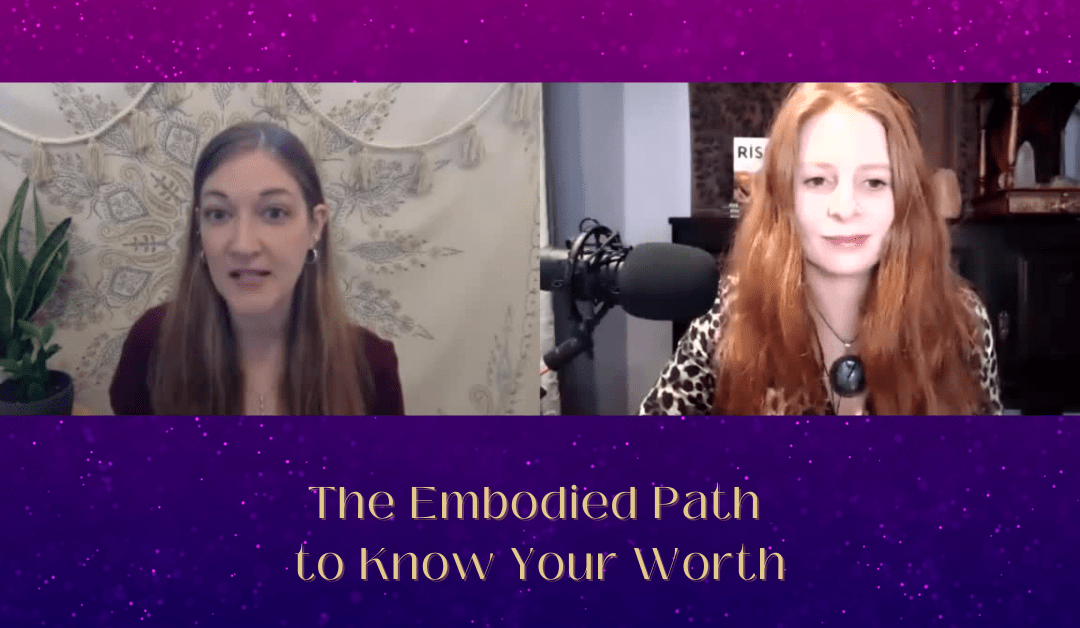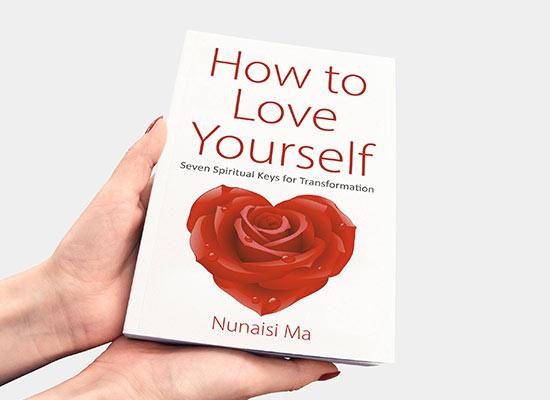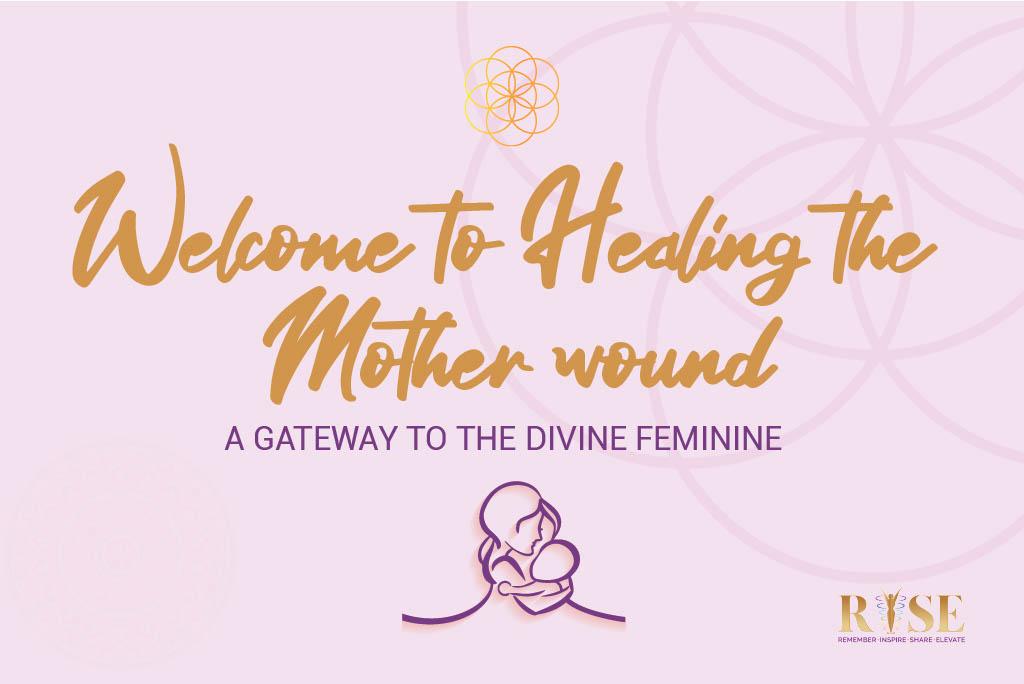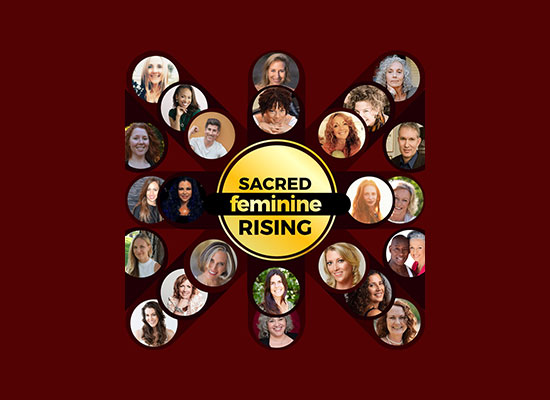Kerry Heckman
Nunaisi 00:00
Hello, and welcome to Rise. I have a special guest with us, today, and her name is Kerry Heckman, and she is a licensed therapist in private practice, in the Seattle area. She specializes in somatic psychotherapy for the treatment of trauma. Her aspiration is to help people heal generations of trauma and know their worth. Kerry is also a freelance writer and speaker on the topics of mental health and complex illness.
You can find more information on her website, kerryheckman.com, and the link will be below. Hello, Kerry, and welcome, welcome, welcome.
Kerry Heckman 00:45
Hi, thank you so much for having me. I’m very glad to be here.
Nunaisi 00:50
It’s great to have you. You are very aligned with the theme of the summit, healing people from generational trauma. And I know we’re going to dive into the topic of the embodied path to know your worth, and I can’t wait to dive into it. Do you want to maybe start by telling us a little bit about your personal story and how you ended up doing this kind of work?
Kerry Heckman 01:21
Sure. So, I became a social worker in my 20s and I worked for many years with adolescents in schools, and through that work, it was a pretty intense environment, and eventually, my body burned out and I became ill, and needed to leave that environment. And I kind of took it as a message of, we need to pivot, we need to shift, this isn’t working for you, anymore.
So, it seemed like the more I removed myself from that environment, the better I started to feel. I still have complex illness and I’m still working on embodied healing, but now I’m able to listen to what my body is telling me and follow that as a message rather than a symptom, and I got the feeling that even my environment needed to shift. And so, my husband and I moved to the west coast, to the Seattle area, because I felt really good in fresh air, and I felt really good by the water and by the mountains, and in the trees. And just by chance, I met a woman who practices somatic psychotherapy, and I started to be her student and learning the process of somatic psychotherapy, or body-based psychotherapy.
And where I was living, in the Midwest, it’s not as present or it wasn’t as present as it is out here in Seattle, and so I just think about the process that I had to go through to kind of find this work, and know that this work helps me and it also is so beneficial for people who have trauma.
Nunaisi 03:49
Yeah, absolutely. And you found it and that found you, right. I would like you to maybe just explain a little bit what is somatic psychotherapy for those that don’t know, and then we can carry on from there.
Kerry Heckman 04:07
Right. So, somatic psychotherapy is different from traditional psychotherapy, in that, it is a bottom-up process. So, in traditional psychotherapy, we change our thoughts, then to change our feelings in our body. So, that’s the top-down approach. And then, in somatic psychotherapy, we work with the sensations of the body to align our thoughts. So, it’s this bottom-up approach that’s done through exploration of the sensations of the body, listening to the somatic experience of the body. There are multiple modalities of somatic psychotherapy, there’s not kind of just one way to do it, but yeah, that’s a general overview.
Nunaisi 05:09
Right. So, it’s listening to what is happening in the present moment in the body and working with that, and then, there’s a process to navigate the thoughts accordingly, right?
Kerry Heckman 05:25
Right. So, we often find that if we can regulate the body, even if we can regulate as trauma responses arise in the body, and then we co-regulate, myself, and the person that I’m working with, then we notice that the ability to see things as they are comes into being. And it’s always phenomenal, every time I witness it, like, wow, really, when we can regulate the body and we can come to a state of optimal arousal in the nervous system, we can really reason and understand things a lot differently than when we are in kind of the default setting of dysregulation or within the trauma.
Nunaisi 06:21
Right. So, what is the path of self-worth and how can one start walking that path?
Kerry Heckman 06:31
Really, what I feel is what I really want people to know, I believe that when people go through generational trauma or traumatic events in people’s lives, or developmental trauma, there are so many ways that the body becomes dysregulated. And one of these ways is to – let me rewind a little bit and I’ll talk a little bit about what happens to the body when trauma is present. So, people likely know about the survival states of fight, flight or freeze, and when trauma is present, especially if it’s present for somebody as a child or through generations, the body kind of reaches a default setting of either fight, flight, or the freeze state. And the freeze state is the one that we don’t talk a lot about, we talk a lot about fight or flight, we talk a lot about kind of anxious and over-activated, and this hyper-aroused state, we don’t talk about as much about the freeze state, which is the body’s third – kind of what it moves into, if it can’t fight and it can’t flee, it moves into this freeze state, and it’s basically a shutting down of the nervous system and the body, and our movement, and we go into this frozen place, and that is the place that is aligned with shame.
So, people might recognize, oh, yeah, when I’m in a real spot of feeling a lot of shame, I feel paralyzed, and I feel like I can’t really make any decisions or move forward on anything, because I’m really frozen. And those feelings of shame, from trauma, live within our viscera, and so, these are where these feelings of self-loathing and shame live within us, but the thought process, often behind that, is this thought of being uniquely flawed in the world. So, I am so bad, or I have done so many things that are so wrong, that even though everyone else in the world deserves grace and deserves understanding, I don’t belong to that group. And so, what’s really important to understand is that it is from that freeze space that those thoughts arise, and that no one is uniquely flawed, and that everyone does belong, and deserve grace and understanding.
So, that really is the message, is knowing where it’s coming from. It’s coming from these trapped shame experiences in our viscera and this is the thought pattern. Even though it sounds very different than maybe the feeling, we can very much convince ourselves that we are uniquely flawed in the world, but the truth is that that is the thought pattern that arises from that space of shame. And so, once people start to understand that, then we can say, okay, what can we do about that? How do we bring movement and bring release to those trapped experiences in our body? And that is the process of regulation and some of the somatic work, co-regulation with another person, belonging to a community.
I can definitely go into all of that space, but it’s really the understanding of where does this lack of worth come from.
Nunaisi 11:09
Right. So, yeah, you gave an overview of how shame is frozen in the body, happens in a state of trauma, where there is feelings that may be too difficult to process at the time or there is a sense of disconnection, from maybe a person that is close to us, or a group of people, or even from ourselves. If the body doesn’t feel a safe space, then there is a disconnection from our own body. And really, from what I know, is that shame is the fundamental feeling of disconnection, and I know that the antidote to that is to be vulnerable and create that connection, and that dissolves shame. Do you want to maybe speak into that and how does that relate into self-worth?
Kerry Heckman 12:14
Absolutely. So, I think what you said is very important, about this disconnection. This disconnection from ourselves, disconnection from others, this feeling of “I don’t belong”, and it’s incredibly lonely in that space. And so, coming back into connection with our body, and with another. Which, I don’t say that and present that in a way that it’s easy, or that it happens quickly, especially for people who have a lot of trauma, that is an incredibly difficult, slow process. But, what is the goal, essentially, is that feeling of connection, and that feeling of connection helps our nervous system to feel safe, and then we can move into regulation.
And the thought process that comes out of regulation is, maybe I’ve made mistakes, or maybe there are some things that I would like to work on in my life, but I feel okay, I believe in myself, that I can get there. I believe in myself, that I have value, and that I can start moving in that direction. Sometimes, I ask people to think about times when they felt calm or felt vitality, kind of that alive sensation in the body, and think about, well, how did you feel about yourself in that moment? What was different in that moment, when you felt calm or you felt vital? And oftentimes, it’s this awareness of, “oh, when I felt that, I was able to access self-compassion, I was able to take it slow, I was able to give myself a break, I was able to be kind to myself”.
And I think sometimes people don’t recognize that that is self-worth. We think of self-worth if we don’t feel it as, oh, I want to look a certain way, or have a certain job, or have a certain relationship, and that equals worth. But really, self-worth is a feeling, and it’s a feeling of self-compassion and it’s a feeling of kindness towards the self, and oftentimes people can access that if they think about a time where they felt calm and vital.
Nunaisi 15:09
I love that. That’s very important to highlight, because self-worth comes from the inside out. It actually does not attach to any external achievement, any degree or material belonging, any of that. It can be part of your identity, but if you attach yourself worth only to that external, then it’s not really integrated in the authenticity of your being.
So, every person that is here on planet Earth is worthy of love, is worthy of accepting, of belonging, of celebrating the fact that we are here. It takes a lot for us to come here, actually, so many things need to happen, and only for us to be born in this body, that this is already our worth. Everything else is just on the periphery and it can be added, but it’s not the essential value of our worth, which is an inside feeling, as you said.
You know, when I was living in PachaMama, which is a community in Costa Rica, I remember we once did this intensive workshop called Who Is In, and really, it’s a powerful process, where for three solid days, we keep changing partners. I don’t know, maybe 100 people in the big room. And we don’t speak in between, but the only question we ask each other when we split into couples is, who is in? And in the beginning, we come with all those very broad kind of identification of “I’m the body”, but I’m actually beyond the body, or I’m the mind, but I’m actually beyond the mind. I’m what I have, but I’m beyond what I have, and slowly we’re peeling all those identifications, until we really embody that realization that we are divine spirit in a human body. It’s not something we can really put into words or find a language for, it’s more like a question that is more like a quan. It’s not a question that is really looking for a defined answer in a language that can really nail it, it’s more like a process of realization that, who am I, who am I here? So, yeah, that just reminded me of that process.
Kerry Heckman 18:28
Yeah, absolutely. I think about the connection that you probably were forming over that time with the other people and how that helped foster that space to come to that regulation in the body, optimal arousal, in order to know those things about who we are.
Nunaisi 18:51
Now, when you say optimal arousal, please speak into that. I just want to have a definition for that term you’re using.
Kerry Heckman 19:02
Yes. So if we think about something called neural states, so these are the states of our nervous system, and oftentimes, we can understand, okay, a hyper-aroused neural state is, what we might call in the mental health world, anxiety. So, the hyperarousal is this anxious activation, muscle tightening, our heart rate increases, our breath shallows, and we’re very, very alert and aware. So, that’s kind of that hyperarousal neural state, that’s your fight or flight. Then, we have our low arousal or our hypo arousal, and that is the freeze state, and in that, we notice like collapsed posture, a lot of hopeless feelings, frozen, kind of in that viscera, in that gut, frozen feelings in the gut, or nausea in the gut. And then, in between that space, there’s the high arousal, there’s the low arousal, and then in between that space is our optimal arousal. So, this is our calm vital space of, I feel alive, it’s an aliveness of being in the present moment, not in the future of the hyperarousal or the past of the hyperarousal, but being mostly present and feeling calm, and alive.
So, that’s our state of connectivity, and often people describe it, oh, it’s if I’m being creative. So, if I’m engaging in a creative activity, or if I’m with someone I really love, or I’m with an animal that I really love, people will describe feeling that optimal arousal.
Nunaisi 21:11
Right. So, it’s again, when we are connecting to either another being, it can be an animal in this case, or connection to the flow of lifeforce energy, which is the creativity, we feel in that zone, or connected in our own body, and feeling that aliveness. So, it’s really, when we have that connection, and diving into the present moment, which is really where we can feel a connection from.
We cannot feel connection from the past or future, we can only feel that connection from the present moment. So, really, the work is to regulate that nervous system, and find that sweet spot in the middle where we can feel that connection.
Kerry Heckman 22:08
Right. And, if you’d like, I can go into a little bit of like, how do we regulate the nervous system? What are some ways to do that, both on our own, and really in the early stages of trauma healing, I really think about co-regulation. So, how do we regulate with an embodied guide, or within a community before we are able to effectively self-regulate on our own. Although, there are some ways that we can self-regulate, and one of the most commonly spoken about is meditation, or some sort of gentle movement, like yoga. Sometimes these things are not accessible to people due to not being able to sit still in a hyper or hypo aroused place, because then a lot of thought processes are very scary to sit with. So, it’s really about listening to yourself and knowing if you’re in a place to engage in that type of activity.
And Yoga, a lot of people who have trauma, we know also have chronic illness or difficulty in their body, so sometimes thinking about, is that something that’s accessible to you? So, sometimes we think about how can we embody outside of the body, because embodiment is really just a state of regulation, and so, we don’t necessarily have to come into the sensations of our body in order to regulate, we can ground and regulate through.
There’s a process called orienting and orienting is where we just listen to the sounds that are in our space. So, there might be traffic or birds, or something, just orienting to your space through the senses. So, through hearing, through sight, kind of slowly scanning the room that you’re in, finding what your eyes are attracted to, this is incredibly calming for the nervous system. So, we don’t necessarily have to engage with discomfort and feeling, and thought, we can engage with things that are pleasant outside of the body.
There’s many other ways; we can be in nature. Often, one of the first things I ask people to consider is what element they are the most connected to, and everyone always knows, they know the one or two earth elements that they feel a connection to. Even if spiritual practice and spirituality isn’t a part of their general day-to-day, they always know, oh, I love being by the water, or, oh, I really love walking in the forest and connecting to the earth. And so, we can either visit those things in real life or we can visit those things in our imagination, through imagery, and our body just knows, like, oh, this is my calming connected element.
Nunaisi 25:49
Yeah, absolutely. I like how you describe that in some certain, maybe severe states of trauma, or when it’s completely unprocessed yet, and it’s in the muckiness of it, it might be frightening for people to meditate or do yoga, or engage in any kind of activity that kind of brings them back home. So, it’s easier to connect through the nature, through the body of Mother Earth, and slowly through that come into the body and make the body a safer space. Right?
Kerry Heckman 26:34
Right. Yeah, this whole process is about attuning to your own body, because often in trauma, maybe your caregiver wasn’t very attuned to what you needed and your needs, or maybe there was such a disconnection that it was very difficult for you to attune to what you need. And so really, that not moving into anything that isn’t attuned, isn’t aligned with what you need in that moment, because there’s more healing in listening to yourself that meditation is dis-regulating, than there is in forcing yourself to meditate. So, it’s really about, oh, if I can listen to myself and do what works for me, then I’m actually regulating because I’m attuning to myself.
Nunaisi 27:35
Right. And things can also change and transform as we go along the path, right? You might not be able to meditate now, and after doing some work, and taking it really slowly, and really listening and attuning, and aligning, maybe in a couple of months, or a year or so, you might be able to see just for a little bit and slowly grow it up. So, it’s also not to completely close those doors, maybe just revisit them every now and then, to see if there is an alignment then, right?
Kerry Heckman 28:12
Right. And that’s our markers, that’s how we know that our nervous system is coming into more of familiarity with what regulation is, because we can notice these things of, oh, well, I am able to sit for five minutes, or I am able to go on a walk without having to have my earbuds in, I’m able to be with myself a little more. So, we have to have those kinds of milestones along the journey to know that things are moving, that things are shifting.
Nunaisi 28:56
Right. And of course, there’s many ways to do yoga, and there’s many ways to do meditation. So, also, maybe try a different method, a different way, maybe more gentler like yin yoga, maybe a meditation that perhaps in the beginning is more like a mantra orientated, so it’s really focusing the mind on to a central point, it’s not really giving that spaciousness for the thoughts to move freely. So, yeah, there’s also really many ways and one needs to find a way that’s aligned. And as we’re changing and transforming, that can also change and transform as we grow, right?
Kerry Heckman 29:48
Yeah. That kind of makes me think of an important thing to mention, is that in trauma we often notice kind of all or nothing thinking, so kind of this right or wrong, or yes or no, I’m either all good or all bad, there’s no space in the middle. And as we start to notice healing, we start to notice some flexibility and some ability to move in some of that nuanced space of, oh, it’s not that I can’t do these practices, it’s that I need to take it slow, or I need to do it a different way, or I need to do it at a different time of day, and we can start to problem solve, and learn more about what works for us. And that is available to us when we start to bring in the edges of those splits that happen in the nervous system and trauma, because that’s how we find safety.
It’s not wrong to have that way of thinking because that way of thinking is much more certain and it’s much safer, and the uncertainty, and the unknown is much scarier, understandably so. And so, even that’s another practice of regulation is finding the middle and attuning to the middle space, and is there other things that are available to me, is also another way we can regulate.
Nunaisi 31:32
Right. Yeah, this is also a very important point, that you mentioned, that people that have been through trauma had to protect themselves. There’s a survival mechanism, really created that binary thinking. And sometimes also, in childhood trauma, I find that people have a problem with setting boundaries, they’re either very, very rigid with their boundaries, or very, very loose with their boundaries. And many times, the rigidness comes because they’ve been violated in some way. So, to protect themselves, they really like, put all those layers of protection, and it comes in that rigid way. So, yeah, I totally agree with you, that as we work through our nervous system and regulate it, and really, I think the number one thing, our basic need, besides the obvious of food and shelter, and all that, is the need to feel safe. That’s the number one, then I would say the number two is the need for love, but even safety is before love, because this is our survival, right?
Kerry Heckman 32:58
Right. That’s our number one need, is to feel safe and to feel safe in our own body, and to feel safe with the people in our life.
Nunaisi 33:10
Right. Yeah. So, I know that you have a little process that you want to take us through.
Kerry Heckman 33:20
Yeah. So, I put together a little less than 10-minute somatic meditation process. So, this is really for people who are in a place where they can come into the body and start to feel the body from within, that’s kind of the definition of embodiment. And so yeah, just inviting people to come with me on this, this short journey and just see what it feels like.
So, let’s begin by finding your seat. This can be on a chair or a couch, or anywhere where you’re able to place your feet flat on the floor. Allow your eyes to close or if that is uncomfortable, allowing your eyelids to close partway, and soften your gaze. Once you find your seat, start connecting with the ground beneath you, place your feet flat on the floor and feel your sit bones connecting with whatever is supporting you. Imagine your feet and sit bones slowly releasing any tightness and giving into the abiding support of the earth. Start to notice the subtle shifts happening in your body just by tuning into it.
First, bring your awareness to your thoughts. Notice if your thoughts are in the future or in the past, and gently guide your awareness back to the present moment by listening to the sound of my voice. In this meditation, I will invite you into embodiment and regulation. Take note, if your body is moving away from regulation, perhaps your body isn’t in a place for meditation right now, and how amazing that your body knows that and can send you a message. Honor it by listening and be curious if there’s something else you need in this moment. Now, allow your focus to return to your feet on the ground, observe if you are able to feel the sensation of your feet from within, sense if you can feel connected to the ground beneath you. Maybe even sensing into the subtle space between your feet and the ground, notice any sensations that arise in your feet as you focus on them, heaviness, vibration, pulsing, shifts in temperature. Maybe your feet feel neutral, notice if there’s a difference between your two feet or if they feel about the same. Check in to see if there is any movement that your feet desire, perhaps alternating, lifting your heels and dropping them to the floor, or some other slow movement. Maybe there’s pleasantness in the stillness, feel into the different parts of your foot, each toe, from your big toe all the way to your little toe, the ball of your foot and your heel.
Now, shift your awareness from your feet to your sit bones. Notice your sit bones and their unique connection to the earth, do you feel more or less connected in your sit bones than in your feet? Again, invite any movement that you’re drawn to, maybe slowly shifting your weight from one sit bone to the other, invite any further release that’s possible in this part of your body.
Check in with your shoulders, invite them to soften and move down. Give into the weight of your elbows to help them move down even more. Our shoulders hold so much, is there any slow movement your shoulders are craving? Let them rise and fall or any other movement that feels good. Tune into the space between your shoulder blades, the space your wings would grow if you had them, what is the feeling of that space from within your body?
As we’ve come this far, check in with the tone and rhythm of your nervous system. Let go of any intention of how it should feel and acknowledge how it does feel. From here, I invite you to look within and be curious if any colors, images, words, or other perceptions are rising up into your consciousness. What do you notice? Play and explore with the perception. Ask it questions, listen for the answers, allow it to change or remain the same.
Now, if it’s possible for you, orient any sounds you’re able to hear in your space, maybe a fan, a birdsong. Then, very slowly open your eyes and orient anything your eyes are drawn to. Maybe color, texture, light, shadow, allow your eyes to interact with it as long as you would like. Before we close, return again to the connection of your feet on the ground and whatever is supporting you, whatever you are going through, the earth is here to support you.
Let’s end our meditation with the words of [Massaro Emoto], if you feel lost, disappointed, hesitant or weak, return to yourself, to who you are, here and now. And when you get there, you will discover yourself like a lotus flower in full bloom, even in a muddy pond, beautiful and strong. Thank you for meditating with me.
Nunaisi 42:20
Oh, thank you so much, that was really quite regulating for my nervous system. I can definitely feel more embodied and more calm in here, and yeah, that was really, really good.
Kerry Heckman 42:37
Thank you. Yeah, I hope that it will be helpful for people.
Nunaisi 42:44
Great. So, we are reaching the end of our conversation, it was really enlightening and informing, and very, very necessary to understand these processes you described. And if people want to find you, further connect with you, work with you, what’s the best way to find you?
Kerry Heckman 43:06
Wonderful. Yes, the best way to find me is through my website, it is kerryjheckman.com, there’s a J in there. And on my website, you’ll find any links to all my social media accounts, information about my therapy practice and my writing, and other things that I do. So, would love to hear from people and have connection with people.
Nunaisi 43:40
Great, thank you so much. So, all the links will be on this page and thank you for coming, thank you for sharing your wisdom and blessings on your way, and keep well.
Kerry Heckman 43:52
Thank you so much.
Nunaisi 43:54
Great. Ciao.
FREE GIFT: Body Based Trauma Skills. Access & Browse the free pdf library full of tools and shares. Understand why a mom who had a c-section can benefit from “finishing her birth push.” Explore how a difficult birth can influence behavior for a lifetime until you know how to “tell the story”. Learn to work with Brain states and fixations, instead of suffering
Watch the Video:
Listen to the Podcast:
Please share all your comments, insights, takeaways, questions in the comments below.
If you feel called to heal your trauma, grab your copy of the Transform Trauma Summit
Transformational Healing Blog: https://nunaisi.com/blog/
Watch more healing related videos: https://nunaisi.com/media/
Listen to other transformation podcast episodes: https://nunaisi.com/podcast/
Healing Complex Trauma with Annie Brook
Don’t let trauma forever distort your life! Get real help and real changes in this online class with Annie Brook. 10 sessions at your own pace. Annie has helped hundreds of clients heal from Sexual abuse issues and she knows the inside out of trauma healing and it’s relationship to the brain and behaviors. Learn body-based tools that get you back in your body, able to process emotions, and to feel sensations without reverting to distorted trauma or infant memory.






